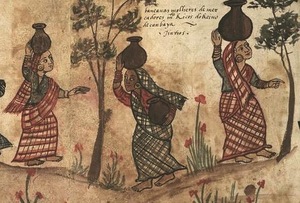
Some months ago my attention was drawn to a post in the BBC News: for the first time would be exhibited in New Delhi a rare book from a 16th-century Italian traveller, Ludovico di Varthema, who compiled adventures and observations in his Itinerario de Ludovico de Varthema Bolognese. According to the BBC post, this was the "first 'travel best-seller' on India, translated to more than 50 languages", enriched with "detailed drawings" which were an essential part of its success.
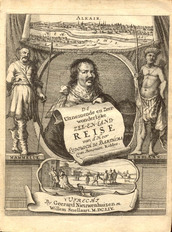
Taking a closer look at the drawings, I noticed something that seemed quite intriguing: they had legends in XVI century Portuguese! Being Varthema Italian and the book's first print made in Italian (it was firstly edited in Rome, in 1510) why would the drawings' legends be in Portuguese and not in Italian or even Latin?
Another article from the Indian Express seemed to corroborate part of the BBC information - the book was being displayed at “Voyages to India of Ludovico de Varthema”. Nevertheless, the same article added that the exhibition comprised "excerpts of Varthema’s book with illustrations", a work translated to about 20 languages(!). This was confusing: did the exhibition consist of the real book or excerpts of it?
Another article from the Indian Express seemed to corroborate part of the BBC information - the book was being displayed at “Voyages to India of Ludovico de Varthema”. Nevertheless, the same article added that the exhibition comprised "excerpts of Varthema’s book with illustrations", a work translated to about 20 languages(!). This was confusing: did the exhibition consist of the real book or excerpts of it?

Messy!
Only two things seemed certain: Varthema's story and drawings looked nice AND both my sources were a good example of bad journalism. But still, why legends in Portuguese? Researching the Wikipedia article on Varthema, which corroborates the drawings and 50 languages facts (both very unreliable information), I read that he joined the Portuguese garrison in 1506. So, maybe the drawings were made under Portuguese commission, later included in the book?
Only two things seemed certain: Varthema's story and drawings looked nice AND both my sources were a good example of bad journalism. But still, why legends in Portuguese? Researching the Wikipedia article on Varthema, which corroborates the drawings and 50 languages facts (both very unreliable information), I read that he joined the Portuguese garrison in 1506. So, maybe the drawings were made under Portuguese commission, later included in the book?

As part of my interest for Gothic art, I've been reading about D. Manuel I, who reigned Portugal in the highlight of our over-seas explorations. He sponsored the Jerónimos monastery and other associated pieces of art, namely the Belém monstrance - to which I briefly referred to in a previous post. This unique piece of jewellery has a fascinating story, but for now the relevant part is that it was made with gold extorted from Kilwah, current Tanzania - a place visited by Varthema.
So, having in one hand D. Manuel I, Kilwah, gold and mysterious Portuguese legends in beautiful drawings, and on the other misleading internet information, I decided to drink from the source and got myself a nice 1863 British edition of Varthema's book. And here we go, trivia style:
So, having in one hand D. Manuel I, Kilwah, gold and mysterious Portuguese legends in beautiful drawings, and on the other misleading internet information, I decided to drink from the source and got myself a nice 1863 British edition of Varthema's book. And here we go, trivia style:
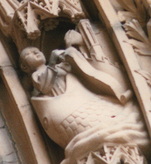
7 essential notes on Ludovico di Varthema
1. Ludovico di Varthema (c. 1470-1517) was a Bolognese who traveled in the middle-East, Asia and East-Africa from the end of 1502 to 1508;
2. He was driven by the avidity for knowledge and exciting experiences, wishing to share his memories with the world;
3. He learned colloquial Arab in a few months and assumed the fake Muslim identity of Yunus (Jonah), what allowed him, for instance, to travel with the Mamlukes and visit the forbidden Mecca, in May 1503. He became the first known non-Muslim to accomplish this;
1. Ludovico di Varthema (c. 1470-1517) was a Bolognese who traveled in the middle-East, Asia and East-Africa from the end of 1502 to 1508;
2. He was driven by the avidity for knowledge and exciting experiences, wishing to share his memories with the world;
3. He learned colloquial Arab in a few months and assumed the fake Muslim identity of Yunus (Jonah), what allowed him, for instance, to travel with the Mamlukes and visit the forbidden Mecca, in May 1503. He became the first known non-Muslim to accomplish this;

4. He wandered extensively from Egypt to Syria, Persia to India, Indonesia and from there to East Africa;
5. In India he joined the Portuguese garrison, later knighted by the Vice-roy Francisco de Almeida for his services for the Portuguese crown.
6. Returning to Europe via Cape of Good Hope, Azores and Lisbon, in an italian vessel, he was received by King D. Manuel I, who enjoyed listening to his stories, reaffirming his knighthood.
7. He expressed the wish to travel further, this time to the "north", but apparently this didn't materialise.
5. In India he joined the Portuguese garrison, later knighted by the Vice-roy Francisco de Almeida for his services for the Portuguese crown.
6. Returning to Europe via Cape of Good Hope, Azores and Lisbon, in an italian vessel, he was received by King D. Manuel I, who enjoyed listening to his stories, reaffirming his knighthood.
7. He expressed the wish to travel further, this time to the "north", but apparently this didn't materialise.
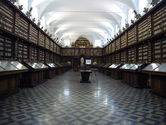
And the legends in the drawings? Well, simple - there are none: no drawings in Varthema's book! That's because the drawings originally belonged to a group of documents named ‘Portuguese Codice’, part of Cardinal Casanata's (1620 -1698) library - more about the subject here and here. The authorship of the drawings in unknown: it's not impossible Varthema did them, but highly unlikely!
Next: Varthema's trip and his eye-witness accounts on widows on fire and 16th-century swingers!
Text by Rafael Fraga © 2013
Photos by Rafael Fraga and WikiCommons.
Next: Varthema's trip and his eye-witness accounts on widows on fire and 16th-century swingers!
Text by Rafael Fraga © 2013
Photos by Rafael Fraga and WikiCommons.
Please share your opinion, insights and critics with us, commenting bellow. We'd love to hear from you! Thanks!
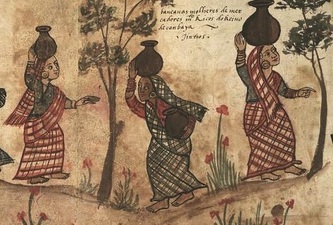
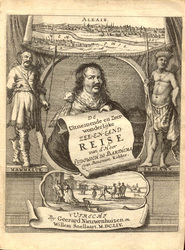
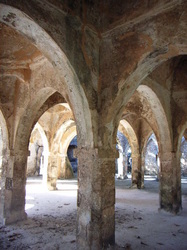
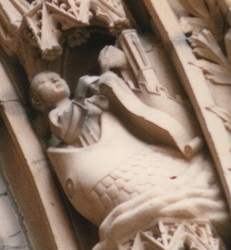

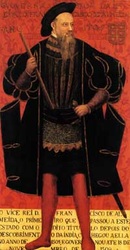
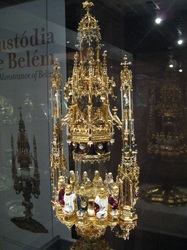
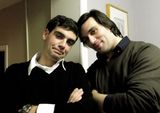
 RSS Feed
RSS Feed
